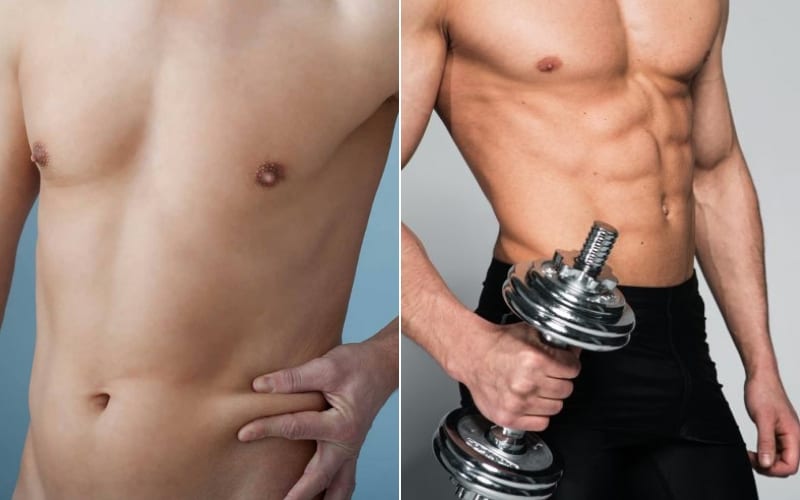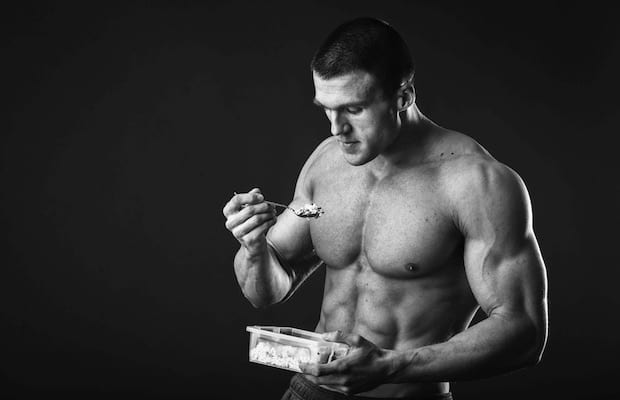No products in the cart.
Building Muscle While Losing Fat : The Secret of Body Recomposition

Is it possible to build muscle while losing fat? Well, it depends on your lifting experience.
If you are a newbie lifter, then it is certainly possible to achieve this goal through a process called body recomposition.
However, if you are a more advanced lifter then, unfortunately, you won’t be able to achieve such drastic results. In this case, you would be better offer undergoing a more traditional lean bulk, followed by a cut.
So what is body recomposition? The following article will look at this process in more detail, how you can build muscle and lose fat simultaneously and whether it really works as claimed.[toc]
What is Body Recomposition?
Your body is made up of fat and fat-free mass (muscle, bone and water), body composition shows how much of each is present.
Body recomposition is a method whereby the body’s ratio of fat to muscle changes.
It has long been used by athletes and weightlifters but has grown in popularity recently among the general public.
Usually people would look at how much they weigh as the main indicator of successful fat loss, however, the problem with this approach is that the weighing scales cannot differentiate between fat loss and a loss of muscle mass.
A body that carries too much body fat is at a higher risk of encountering various health issues [1], while those with a healthy muscle mass to body fat ratio are shown to be healthier overall [2].
Using body recomposition you are able to reduce your overall body fat percentage while increasing lean muscle mass.
Should You Recomp?
Body recomposition is not for everyone, here are some people who may find that this approach works for them:
#1: The Overweight Newbie
A drastic calorie cut may be too much of a jump from their usual diet, so this approach will be a better option.
As they are new to the world of lifting they will experience dramatic muscle and strength gains over the first 6-12 months of training. Make sure you take advantage of these “newbie gains”.
#2: The “Skinny Fat” Newbie
As above they will be new to lifting so will see a massive increase in muscle mass once they start lifting regularly.
A traditional cut will leave them looking worse than when they started as while they will lose the fat they will have very little muscle mass to show off.
Those who are skinny fat are not typical hardgainers. A skinny fat person will likely have little muscle mass and will store fat around their mid-section.
Hardgainers are usually just skinny, and if that is the case then I would focus on a traditional bulking session. So aim to get into a calorie surplus and focus on trying to build mass and overall strength.
#3: Those Looking to Stay Lean Year-Round
Rather than undergoing a bulk, which will leave you with excess fat. And then undergoing a cut, it is possible with this approach to dieting that you can stay lean year-round.
With this approach there are a few things you need to keep in mind:
- If you are losing weight/muscle then you should try and increase calorie intake
- If you are gaining fat then try to reduce calorie intake (protein intake should remain high)
Diet Advice for Body Recomposition

When it comes to body recomp, your diet is probably the most important factor.
There are three steps you need to follow:
- You must figure out your maintenance calories
- Next, figure out your training day calories
- Finally, figure out your rest day calories
There are various calculators online that you can use to work out your maintenance calories, but you can also work it out yourself using the following formula (Harris–Benedict equation [3]):
BMR = (10 × weight in kg) + (6.25 × height in cm) – (5 × age in years) + 5
For training days I would recommend adding 15% to the number of maintenance calories. You should reduce calories by 10% from the maintenance calories figure for rest days.
As for macros, I would personally suggest consuming at least 1 gram of protein for every pound you weigh. 25-30 % should be from healthy fats, and the remaining calories should be from carbohydrates.
It is important that you consume protein as this will help build muscle, and also aid with the fat burning [4].
Although the protein found in your food is incredibly important there is no harm from getting protein from other sources too.
Sometimes it can be difficult to get all of your protein from food alone, which is where supplements like whey protein can help.
Supplementing from whey protein, for example, has been proven to aid with muscle building [5].
There are also pea and hemp whey protein available for those who are vegan or vegetarians.
We are a big fan of the whey protein sold by Battle Ready Fuel.
I would also recommend a change in the types of food you eat, remember not all calories are created equal.
That means that you should really think about cutting out processed foods (junk food) and to increase the number of fresh vegetables and fibre-rich foods you consume. Fibre-rich foods have been proven to help reduce body fat, in particular, belly fat [6].
Training for Body Recomposition

To build muscle you need to be lifting weights, that is a fact [7].
Personally, I would recommend focussing on big compound movements. Such as the squat, deadlift, bench press and military press as they work a number of muscles and will give you the best results for those with little time to work out.
The key is to try and achieve hypertrophy, so you should try to push yourself that little bit harder each workout.
You can do this by increasing the weight lifted, or by increasing the number of reps performed.
I would also recommend cardio alongside your usual weight training, not only for its fat burning benefits but for the overall health benefits you will experience too [8].
There are a few guidelines I would recommend when looking at cardio for recomp:
- If you perform HIIT (High-Intensity Interval Training), then you should limit it to twice weekly
- To keep cardio interesting you can experiment with Tabata and Kettlebells
- Steady state cardio is also recommended as we lead increasingly sedentary lifestyles
How to Track Your Recomp Progress?
If you are attempting body recomp and are looking to track your progress then I would suggest the following:
- Track your gym performance; are your lifts increasing/decreasing
- Take progress pictures
- Measure your body; you should see your waist reduce, with an increase in other measurements
- Weigh yourself
Remember your weight should remain more or less the same. So for every pound in fat lost you should be aiming to gain a pound in muscle.
Does Body Recomposition Work?
Body recomposition does work, but only for some. As stated at the very beginning of the article if you are an advanced lifter then a traditional bulk and cut would be more beneficial.
Recomp is not for everyone, but if you are patient and are willing to remain dedicated to the process then it is certainly possible to see some drastic changes to your physique.
Unlike a traditional cut whereby your calorie intake is cut drastically, this process does not feel like a diet and you won’t encounter problems associated with a reduced calorie diet. For example brain fog and a lack of energy etc.
I would recommend giving this method a chance. It is certainly possible to see some good results.
If you do choose to use this method then we would love to hear from you, leave a comment below with your experiences of body recomposition.
We would also love to hear your questions too!
